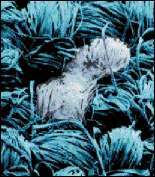Kathleen G. Tatterson
NEW ORLEANS -- Picking cotton has gone high-tech, and soon photonics will help processors pick nothing but the best. Scientists at the US Department of Agriculture's Southern Regional Research Center have developed a system that uses near-infrared (NIR) spectroscopy to help manufacturers quickly and accurately analyze cotton samples for maturity and fineness of individual fibers.
How well the fibers will take dye depends greatly on maturity. Dye imperfections cost the industry about $200 million annually, so a system that can accurately determine bulk maturity is crucial.

A microscopic image of cotton fibers
illustrates flaws in fiber maturity. With the near-infrared system developed by the US Department of Agriculture, processors will be able to catch these flaws online.
|
Current high-volume instrumentation systems that monitor cotton take measurements in 30 seconds at an accuracy considered moderately useful by current standards, said research chemist Joe Montalvo. With NIR spectroscopy, the system can take measurements in 1 second at an accuracy of within 2 percent.
Each cotton fiber is an elongated cell, or seed hair, that grows from a closed seedpod called a boll. When the boll opens and the tubular fibers are exposed to air, they lose moisture and collapse into flattened, twisted structures. The mature cotton fiber is actually a dead, hollow cell wall composed almost entirely of cellulose.
To determine the material's maturity, the high-volume instrumentation system places the cotton sample onto a quartz window. The fast diode-array spectrophotometer, which employs a white light source developed by KES Analysis of New York, emits at 850 to 1700 nm to take the spectrum in 1 second. It simultaneously measures the fiber's cell-wall thickness and its perimeter. The system feeds the data into a computer programmed to calculate the fiber's maturity and fineness and, therefore, its dyeability.
Fewer losses
This will be a great advantage to textile manufacturers, who cannot totally prevent poor-dyeing fiber from getting into mills. Coloring imperfections often are discovered too late, forcing manufacturers to take a loss when they sell the cloth.
Perhaps more importantly, according to Montalvo, is the impact the improved data will have as the US cotton industry looks to expand its market overseas. "We have to demonstrate to the world that our cotton is mature and fine," he said. "This is the real driving force for development of the technology."